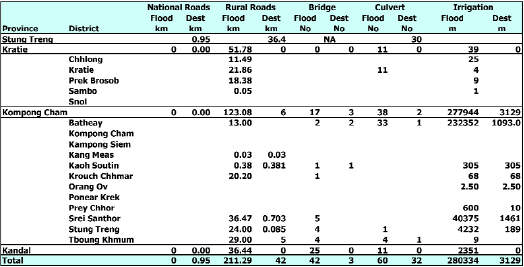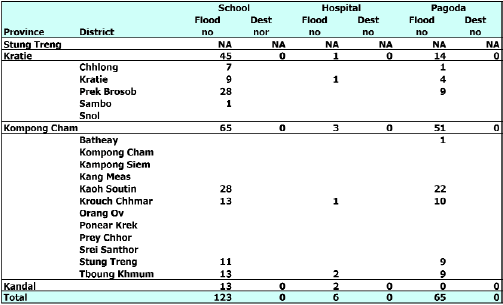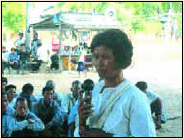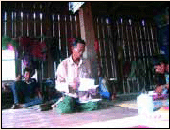7. Impact of the 2005 flood - Country reports (cont')
7.1 Impact of the 2005 flood in Cambodia (cont')
Impact on infrastructure
The damage to infrastructure was limited. Many infrastructure were flooded, causing some erosion but very few were destroyed. The province of Stung Treng seems to have been the most affected, but these figures must be considered with caution as it is not clear if the difference between flooding and destruction was made. It is also likely that some data are missing in the following table as it was not possible to reconcile "no data available" and "zero" value.

Source: Provincial Disaster Management
Committees

Figure 26: Impact on rice production and
livestock in Cambodia

(')estimate damage to private infrastructure
no available
Figure 27: Impacts on infrastructure in Cambodia
Site visit to the affected areas
The team in charge of preparing the MRC Annual Flood Report 2005 visited the three most affected provinces: Stung Treng, Kratie and Kompong Cham. Meetings with the provincial and distrtict Authorities and visits to some particularly affected villages were organised. Informal discussion with head of villages and villagers allowed the Team to get a better understanding of the severity of the flood, and the way the villagers and authorities tackled this difficult situation before, during and after the flood period.

In the villages of Phum Kang Cham and Phum Poung Touk, Stung Treng Province. Local women told what happened: "My house has been flooded every year from 1996 to 2005. In 2005, when the water level was 0.82 m, the Red Cross told us to evacuate to a safe place, but my house and my rice field were flooded. In my village 20 families were affected by the flood in 2005. The paddy fields were also flooded and we could harvest only 20%, so we did not have enough food last year. We received some support from the community and the Government but we think it was not enough."
The Mekong does not normally overflow from the mainstream in the provinces of Stung Treng and of Kratie. Heavy floods are seen by the villages as a serious concern, even if they are used to coping with this situation. It is likely that the flood contributes to increases in fish production, but agriculture (which is the most important activity) is generally affected by severe flood. Therefore, flooding events with water levels overtopping the river embankment are not perceived as profitable. Such floods do not occur every year and people have to deal with exceptional situations. Floods occurred in many villages in 2005, mainly near the confluence with tributaries or in places, where the level of the Mekong embankment is loweras a result of as a result of backwater effects.
In the province of Kratie, infrastructure and settlement were affected by flooding but to date it has not been possible to obtain a comprehensive report on the damage. The figures reported by the province (PDMCs) do not quantify the level of damage, nor the assessed amount needed for repair or reconstruction. Some figures probably do not exist at technical department levels, but are most likely partial and are not necessarily validated.

Flood in Kratie Province - pictures PDWRAM, 13 Sept 2005
The section downstream of Kratie is typical of the Cambodian floodplain conditions. Large areas are flooded every year. People are accustomed to managing this situation, by protecting the livestock, making provision of food and harvesting earlier when necessary. The 2005 flood was perceived as a "balanced" flood even if many villages were affected. The villagers recognised that the 2005 flood improved fishing activity, brought sediments in the cultivated areas and eradicated rats.

Village of Prek Toch - Kompong Cham Province: The chief of the village reported that the flood had to top a well known mark to be profitable, but should not top another mark otherwise it would become more damaging than profitable. It is likely that many villagers in the floodplain have a clear understanding of what is the minimum and maximum limit of water level that makes the difference between a "balanced" flood and a "damaging" flood. It should be possible to create a map showing those limits by carrying out village surveys.

10 deaths of children were recorded in 2005. Bathing in the
river is one of the main causes of death. Housing is adapted
for the long periods of flooding that occur every year in
the Cambodian floodplain. Homes are built on high pillars
and generally the water does not rise above the floor of the
living quarters.
Choose a newsletter: